It would be impossible to tell the story of Britain’s westernmost tip without mentioning the sea. This once-isolated sliver of the country, surrounded on three sides by water, has a unique affinity with these inharmonious waters spanning back centuries that is not only evident today, but helps define the very essence of Cornwall.
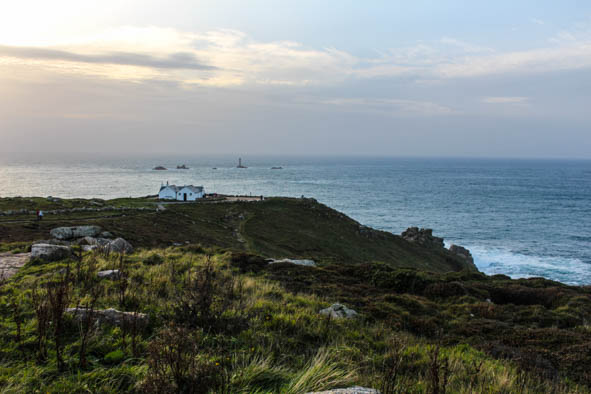
Sunset over Land’s End (Photo: Paul Stafford)
Water entered my walking boots as my foot sank into the soggy ground. I had just circumvented a sign warning people that they advanced further at their own peril. I scrambled down the gully to the tiny inlet called Castle Zawn where an irate sea writhed and frothed. The shipwreck was too enticing to ignore.
I tried to get closer. Yanking my foot from the mire I scrambled down to the first panel of rusted metal. More shards were strewn out over the rocks like dead rose petals, thick and jagged. They had once made up the bow half of the vessel. The stern sat at an awkward angle, relentlessly pummelled by high tide’s inconsiderate vanguard.
Climbing over a particularly gnarled metal panel I watched as wave after relentless wave broke upon RMS Mulheim’s hull; surrounded by the results of a decade of attrition. I tried to scramble closer to the remaining hull of the Mulheim wreck. It looked impassable. The metal groaned and the sea swelled around it, preventing access.
The Sailing Almanac writes that “fair weather is essential” for a passage around Land’s End. The weather was fair but you would not think it to watch the sea at work.
Exhumation and Back Again

Waves batter HMS Mulheim’s weary hull (Photo: Paul Stafford)
It was on a slightly foggy night in 2003 that the RMS Mulheim ran aground. Inclement weather had not led to the crash however. The chief officer had fallen and was knocked unconscious. Cornwall gained another wreck; more than 6000 ships have had a similar fate along the coast of the peninsula county, stubbing the toe of Britain.
The first recorded shipwreck in these seas was in 1284, although Cornwall has plenty of unofficially recorded history to suggest that this was not the inaugural naval disaster in the region. Recent excavations of a far older shipwreck found tin ingots buried with it, but the wreck itself did not yield a reliable date during tests.
Looking out from the cliffs at Land’s End I wondered how many other craft lay beneath the waves, far from view, perhaps never to be seen again.
Tin is a simple metal to mine, and Cornwall has been much valued for its extensive supplies in past centuries. As I drove towards Land’s End stubby brick edifices hugged by stout chimneys jutted above expanses of browned heather. Their appeal is now merely aesthetic, but once they were responsible for the livelihoods of Cornish miners for millennia.
Bronze is an alloy of tin and copper and so, when the Bronze Age reached Britain’s shores around 2100BC, Cornwall became a site of early significance. Tin mines sprang up all over, with a large concentration around Land’s End.
Having come from London that very day, it seemed strange to think that Cornwall would have been considered one of the most significant regions of the country in terms of trade around the time the Romans invaded. Meanwhile London would have been little more than a scattering of scratty Celtic villages. The tin was usually transported as far as Exeter, but Land’s End was well known to the Romans. Ptolemy named it Bolerium, or ‘Seat of Storms’, which suggests the seas there always had a deadly reputation.
Hallowed Ground
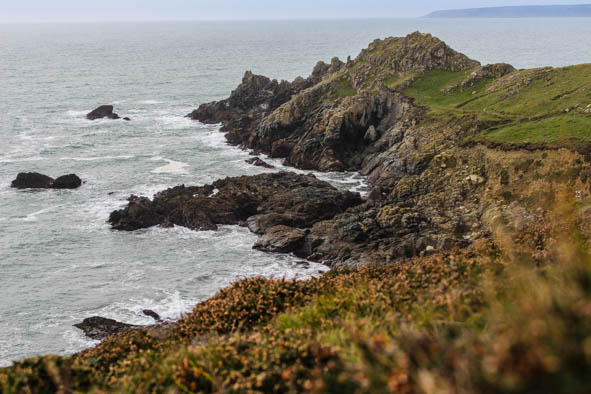
Intriguing visitors from afar may have been drawn to Cornwall’s shores (Photo: Paul Stafford)
Cornish tin has long drawn important figures to Cornwall, bestowing great significance on the region. A few decades before the Romans arrived, Cornwall had a connection to a very unlikely person whose very existence, let alone his presence in Britain, remains apocryphal.
During the ‘Unknown Years’ of Jesus Christ, one theory suggests that he spent time in Cornwall. Guffaw as you might, there is a basis for the story, however impossible it would be to prove. The theory rests on the idea that there was Jewish involvement in tin mining 2000 years ago, and that Joseph of Arimathea travelled to Cornwall as a trader, bringing a young Jesus along with him.
Strangely enough, there is no recorded reference of this until the 12th Century, which coincides with the first known arrival of Jewish miners in Cornwall. The Jewish Encyclopedia states “there is distinct evidence of the connection of the Jews with the stannaries or tin-mines of Cornwall in the reign of King John. [1199-1216]”. It goes on to note “There are no other traces of Jews in Cornwall in early times.”
What is certain is that the outside world was aware of Cornwall and the seas around it from an early period. Although few Roman relics can be found in Cornwall, wanderers and documentarians of the day would have made it right to Land’s End and have left written records depicting a people comfortable in their surroundings who eschewed ostentation and bravura. Diodorus, who wrote an extensive history of the world known to the Romans, stated that the people of Land’s End “were much more civilised than the other British nations”.
This is still evident. Many of the villages in the surrounding countryside are simple and pleasant. Ancient walls, known as ‘hedges’, demarcate land boundaries that have stood for generations. Change only comes in commercial forms, but the essence of these dwellings has likely remained the same for centuries.
Honesty
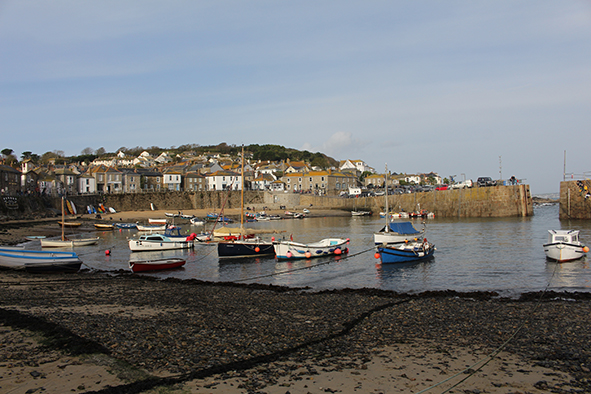
Boats at low tide in Mousehole Harbour (Photo: Paul Stafford)
Earlier in the day I had wandered around Mousehole (pronounced ‘Mowzel’); a quaint fishing village. The harbour built to protect the village’s fishing boats is easily the largest feature in the village. Gently tumbling towards the water, the houses, like in most Cornish seaside towns, stand out for their yellowing roofs.
Xanthoria lichen is the culprit. It grows freely on flat surfaces exposed to sea air and sun. Lichens do not need soil to thrive, just plenty of sunlight and nitrogen compounds. Therefore the roofs are ideal for the xanthoria in more ways than one. Not only do they provide fantastic sun exposure, but they are popular resting places for the omnipresent gulls, which if not seen are almost always heard in Cornwall. Their love of rooftop perching and penchant to defecate where they stand creates the lichen’s ideal habitat.
The most noticeable monument in Mousehole is not dedicated to a resident lost tragically at sea, but rather one lost on land to a once far greater sea-borne threat. A slate plaque solemnly declares that the house on which it is mounted is the oldest in the village, circa 14th Century, after the rest of the village was burned to the ground.
Although never officially declared, England was at war with Spain from 1585-1604. Protestantism and piracy were the main reasons. Queen Elizabeth I had followed her father in moving England away from Catholicism. The resultant excommunication from the Vatican encouraged ‘good’ Catholics to wage war against Protestantism. Meanwhile British privateers had become increasingly troublesome to the Spanish ships returning home laden with silver and gold from South America.
The Spanish Armada was potentially the most serious consequence. Having first been spotted from Lizard Point in Cornwall, things worked out in England’s favour and the Armada failed. Seven years later however the Battle of Cornwall took place – although it was more of a surprise raid than a pitched engagement. Some 1,000 Spanish troops disembarked from four ships and burned Mousehole and the villages through to Penzance before retreating. The smash and grab left four residents of Mousehole dead.
As I walked through spindly alleys the weather was pleasant and warm. A number of boats lay askew on the sand as the tide pulled water out of the harbour. The gaily painted boats ranged in size from a two-person rowing boat to modest-sized fishing boats. The complete absence of commercial-sized trawlers gave the village an air of subsistence and simplicity without any of the austerity.
During the night the whole place was transformed by thousands of twinkling little lights strung through the salty air via sturdy eaves. The sea at its most peaceful since I had arrived in Cornwall, gently lapped the sand; its rhythmic susurrations like a mother consoling a weary child.
The oft-uncongenial nature of the waters, although deadly to so many, has produced some very accomplished seafarers. One such fisherman has his own day of remembrance in Mousehole.
Tom Bawcock’s Eve is Christmas Eve Eve to most people. But in the 700-person village, locals commemorate one night in the 16th Century that Bawcock braved heavy storms in his fishing boat to end a famine that had descended upon the village. After protracted storms had prevented the boats going out for some time, Bawcock caught seven different kinds of fish atop churning seas. The fish were all baked into a single large pie with their heads sticking out and thus stargazy pie was born.
Although Cornwall is famed for its pasties this famine-busting concoction – still made today with fish heads peeking out – might be Cornwall’s most unique culinary offering. Food and sea linked, in both content and folklore.
Dishonesty
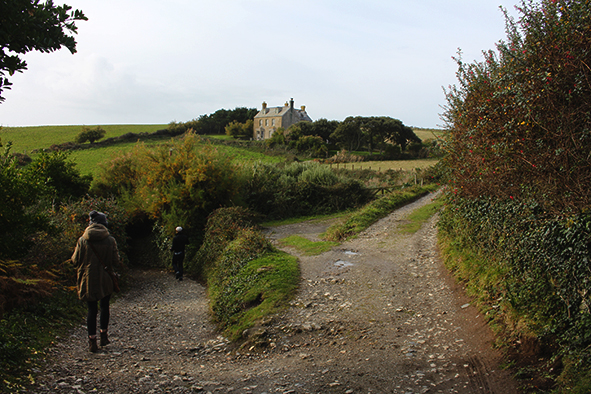
One of the houses near Prussia Cove (Photo: Paul Stafford)
Not every village along the Cornish coast shared Mousehole’s wholesome relationship with the sea. Heading further east away from Land’s End, on the other side of Mount’s Bay from Mousehole, the ragged coast takes on something of an untamed atmosphere. Cliffs rise and dip from the swell, sometimes converging at precipitous peaks or giving way to ensconced inlets and coves. It is around here that, with some difficulty, Prussia cove can be found.
The road ended abruptly and I had to negotiate the rest of the way on foot. A small scattering of old houses sat nestled among thickets of gorse and hazel. They commanded a regal view over the sea down below; one house was located unnervingly close to a steep precipice that ended some way down on a shingle beach. These were the houses built by the Coastguard to ward off a repeat of perhaps the most revered smugglers known to Cornwall.
The Carter Brothers: John, Harry and Charles worked the surrounding land during the latter half of the 18th Century. Their father was a miner who instilled an ethic of religion and hard work in his children. Something about this simple lifestyle drove the brothers towards wanting more; to make money and to become something.
By 1777 the three brothers had turned what first began as a small-scale smuggling operation into a lucrative business. They had a new 197 ton cutter built with space for a number of cannon. Older brother John had become increasingly known by his nickname ‘The King of Prussia’. But as quickly as the legend grew, the brothers faced their first major run-in with the law. Their arrest and subsequent loss of the cutter saw Harry and John in prison for a year.
Prussia Cove is an umbrella name for the group of four small coves, of which, Bessy’s Cove was so shielded that boats waiting in the watery inlet could not be seen from the land. A series of small caves and crevices in the rock sufficed for storing items until it was safe to haul them up.
The path leading down towards Bessy’s Cove, above which the houses I had seen on arrival loomed, was beset on both sides by thick hedgerows that not only obstructed the view on either side, but were frequently filled out overhead creating what would ostensibly seem like a pleasant and verdant walkway. The path meandered to the east, away from the best vantage point of the cove, before swinging back severely on itself.
Something about this seemed suspicious. Suspicious and clever. The dense hedgerow not only prevented a good view of anything, but it also removed the element of choice out of walking. One had no option but to reach the houses by this singular route, which could easily have been barricaded to slow down ingress. Crucially, it allowed inhabitants of the houses a chance to see any government officials or undesirable visitors arriving long before they themselves were seen.
When I finally reached the first of the houses, terse signs warned ramblers such as me that the houses were private property and not places to mooch around, looking for clues to the presence of stashed contraband. I contemplated disregarding them in true vagabond spirit. Pithy rules were made to be broken. As I approached the side of the building a man stepped out and lit his pipe. He glared at me, took a deep drag and exhaled a laconic nod.
Gone Smugglin’
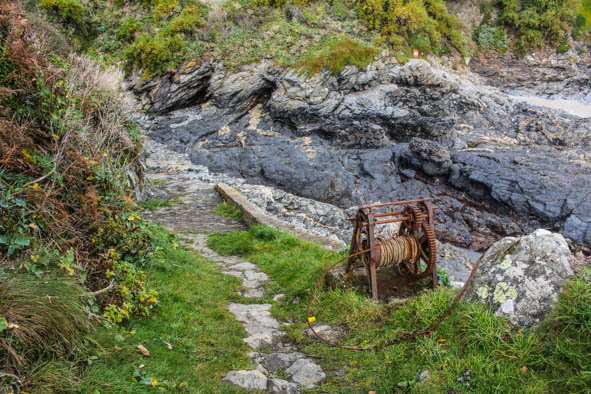
A winch system to drag up booty from the cove (Photo: Paul Stafford)
A combination of isolation and Cornish nationalism contributed to a rather swift rise in smuggling in the region during the 17th and 18th Centuries. Much of the smuggling activity took place along the southern coast of Cornwall from which the Channel Islands, Brittany and the Isle of Wight, which often threw up most of the booty, were readily accessed.
Cornish isolation also gives a hint as to the extent of the operation. Some locals simply did not want to pay customs and excise to a government hundreds of miles away that had little interest in an area of Britain depleted of most natural resources by this time, other than the fish stocks and some remaining tin.
Passing the houses at Prussia Cove I peered out over the beetling cliff top. Down below plates of wave-polished rock, revered in geological communities for their tholeiitic properties, were parted by a thin sliver of water. This secretive little cove was perfect for its purpose. Beset on all sides by high walls or rocks that were difficult to navigate, it would only ever be discovered by those expressly looking for signs of skulduggery. Even then, the cove’s inaccessibility would give more than enough time to the smugglers to flee if needed.
I wandered down and picked my way around rock pools and jagged rocks. Here and there rusted bolts hammered into granite were all that remained of a pulley system that would have been used to hoist booty up the cliffs. A metal hoop dug deep in the rock would have allowed the boat to be moored up as it was loaded or unloaded, but free enough to be released quickly in a rapid getaway. The signs of a large scale operation were all around once I realised what to look for. Practically camouflaged.
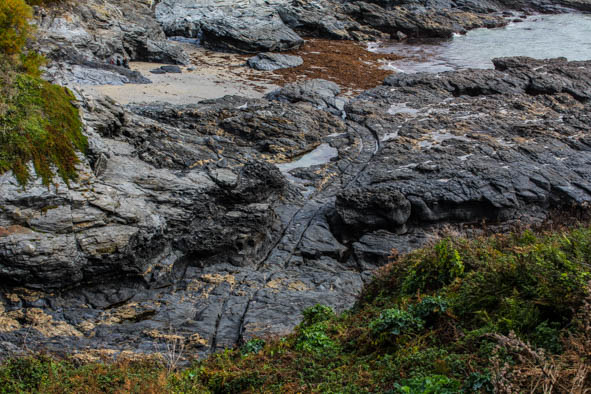
Lines in the Rock. Scars of smuggling are evident at Prussia Cove (Photo: Paul Stafford)
In 1788, a decade after his first major incarceration, Harry Carter was almost killed. His near-death experience was so severe that he repented soon after and became devoted to God and Christianity thereafter, which is when he wrote a rather engaging memoir of his life as a smuggler.
It was in the very bay over which I now looked that he almost met his fate. Customs and excise men sprang a trap, waiting until the Carter’s lugger was anchored before using the cove’s very covert nature against the smugglers themselves. Of the ensuing clash Harry wrote they “pursued me, beating and pushing me, so that I fell down on the deck”. Despite having received some serious blows to the head, he somehow escaped and waded to shore, never to smuggle again.
I clambered back up to the top of a cliff, past a rusted winch of thick wire that would have hauled some incredibly heavy contraband up from the cove. Looking back down at the rocks I was suddenly aware of a far more indelible reminder of the Carter brothers. Carved into the rock were two parallel gashes worn down by some sort of wheeled mine cart, over years of use, to convey heavy shipments of rum, guns and whatever else could have earned the brothers some money.
A Good Place for All That Rum
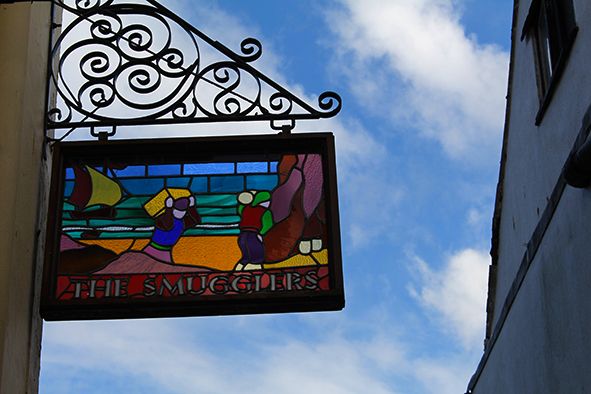
The Smugglers in Looe (Photo: Paul Stafford)
Most of the smuggling in Cornwall was much smaller in scale, for local consumption and to feed local markets that were often deprived of many resources like rum. Being largely cut off from many mainland supply routes also led to a surge in local alcohol production, such as cider.
Even today local cider producers thrive; close to Mill Valley Yurts where I had been staying in a fancy yurt, complete with its own log burner and queen-sized bed, is Haywood Farm. Cider is still made there on a granite press that has been used for centuries, producing cider that likely resembles that which was made during the days in which smuggling was rife.
All along the southern coast are small towns and villages with various links to smuggling, but best represented today by their pubs. In Looe a stained glass sign hangs outside The Smuggler’s Inn declaring that rum was smuggled through a putative underground passage where it was hidden until ready to either consume or transport on. Slightly less believable are the inn’s claims that some of the beams used in the reconstruction there came from driftwood of sunken Armada ships, although no ships are thought to have been destroyed off Cornwall.
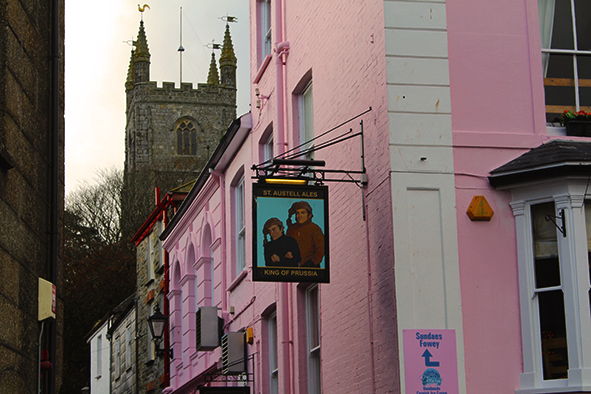
The King of Prussia is honoured by this pub in Fowey (Photo: Paul Stafford)
Further West is Fowey, a lovely little town where even the smallest detail betrays a love and devotion to the sea; every house has a name such as ‘Shrimp’, or ‘Galleon House’. The King of Prussia is a pub right next to the quay where John Carter was thought to have lived for some time in the 1780s.
Then there is Jamaica Inn, a beautiful old building too far from the sea to have been an active player in the smuggling game, but isolated enough to act as a good place for stashing some of the brandy and rum brought ashore without passing customs. It was made famous by the Daphne du Maurier novel of the same name about the wreckers who would lure ships ashore in storms to steal the cargo.
Wrecked
While inebriation has been to blame for its fair share of foundered vessels, wrecking was another, far more subversive, method that accounts for some nautical disasters. Ship wrecking on purpose is believed to have taken place on a few occasions in Cornwall, although concrete proof was never produced.
The premise is simple: turn off a lighthouse at night in order to trick a vessel into a false sense of security. When the vessel, unaware of dangerous rocks, crashes and spills its cargo, a good old fashioned finders-keepers scenario can then ensue.
This is naturally not what happened to the RMS Mulheim at Land’s End. Even if it was, all the wreckers would have found was scrap car plastic. Then again, the stories about the wreckers could just be another Cornwall legend, where the sea is revered rather than feared and boats crash as a natural matter of course; human imagination attempting to make sense of the cruel whims of nature, far beyond our control.
The wind had started to pick up as the sun set over the British mainland’s final outpost. I took a little hip flask from my pocket and swigged at the contents, feeling slightly disappointed that I had paid all necessary duties for the imported rum inside.
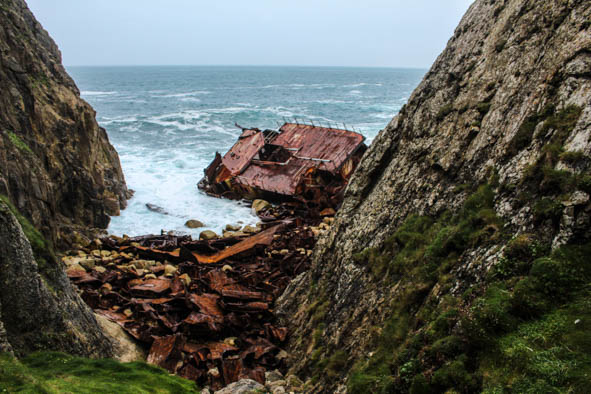
Wreckage of the Mulheim (Photo: Paul Stafford)
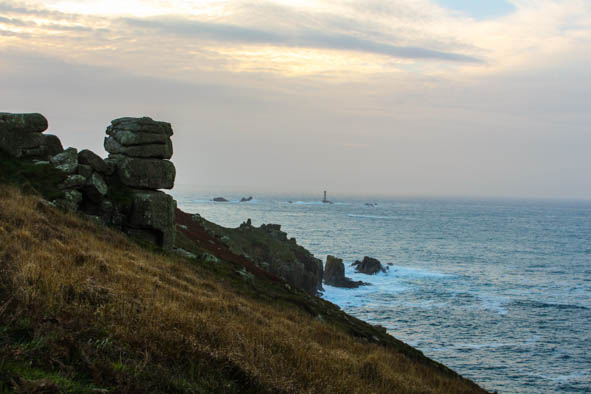
Sunset beyond Land’s End (Photo: Paul Stafford)
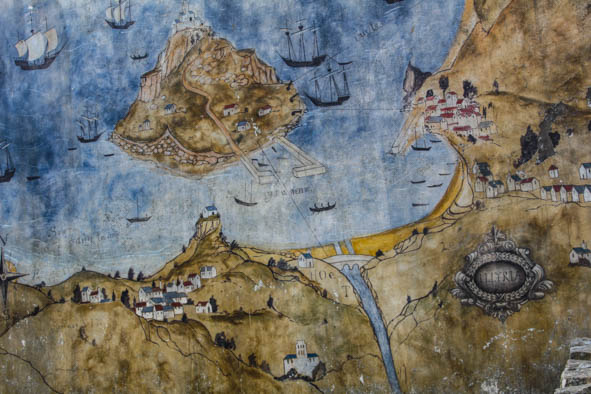
Map of the South Cornwall shore, along which much smuggling activity once happened (Photo: Paul Stafford)
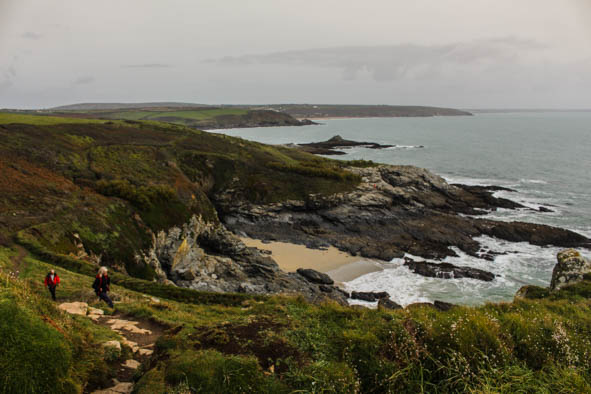
View of the coastline of Prussia Cove (Photo: Paul Stafford)